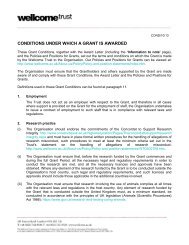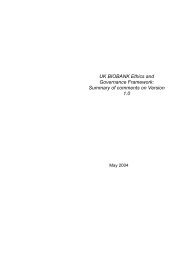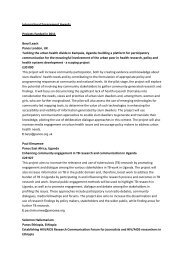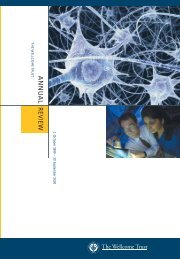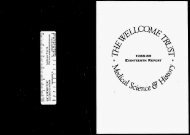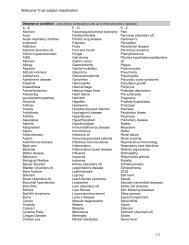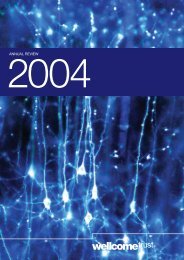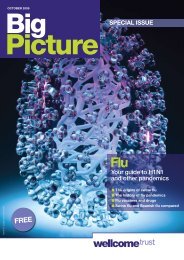You also want an ePaper? Increase the reach of your titles
YUMPU automatically turns print PDFs into web optimized ePapers that Google loves.
32 | DEVELOPING PEOPLE<br />
Brain power<br />
Inner secrets<br />
What links tadpoles, flies’ wings, seahorses and the<br />
human brain? A remarkable protein called Lhx2.<br />
Computer analysis can reveal key<br />
regulatory features in the genome.<br />
1 2 3<br />
How do cells form integrated<br />
structures during development?<br />
Since Hans Spemann’s classic work<br />
on tadpoles in the 1920s it has been<br />
known that certain cells can direct the<br />
fate of those around them, organising<br />
them into a specific structure. Now,<br />
former International Senior Research<br />
Fellow Shubha Tole and colleagues<br />
have identified a key gene, Lhx2, that<br />
controls development of the cerebral<br />
cortex and the hippocampus – a<br />
seahorse-shaped structure crucial to<br />
memory formation.<br />
Lhx2 is a relative of a protein involved in<br />
fruit-fly wing development. Rather than<br />
wings, in mammals Lhx2 has been<br />
thought to be a key specifier of cerebral<br />
cortex. During development, it is found in<br />
cells that become the cerebral cortex but<br />
not in an adjacent strip, known as the<br />
hem, present at the edge of the cortex.<br />
By clever genetic engineering of mice, Dr<br />
Tole and colleagues were able to turn<br />
Lhx2 gene activity on and off in particular<br />
regions of the brain and at particular<br />
times of development. They discovered<br />
that Lhx2 is essential for specification of<br />
the cerebral cortex. It also prevents<br />
these cells from turning into hem cells –<br />
thereby ensuring that the hem is formed<br />
only at the very edge of the cortex.<br />
When Lhx2 was turned off in patches of<br />
cortical cells, however, these cells<br />
became hem cells even though they<br />
were in the middle of the cortex. And<br />
next to each extra hem, a new<br />
hippocampus was formed from cells that<br />
would have otherwise become part of other<br />
cortical regions. This implies that the hem<br />
is an organiser that directs adjacent<br />
cortical cells to form the hippocampus.<br />
This role of Lhx2 is not the only trick in its<br />
book. Dr Tole’s group has found that it is<br />
also involved in the early growth of<br />
nerves carrying sensory information to<br />
the cortex. In fact, it is also needed for<br />
development of the olfactory bulb, a key<br />
structure in rodents’ sense of smell.<br />
It is also active in a stream of cells that<br />
helps to build the amygdala, a structure<br />
central to the processing of emotional<br />
information. This stream of cells<br />
originates from the same region that also<br />
gives rise to the cerebral cortex,<br />
revealing an unsuspected link between<br />
development of the amygdala and the<br />
cortex.<br />
Mangale VS et al. Lhx2 selector activity specifies<br />
cortical identity and suppresses hippocampal<br />
organizer fate. Science 2008;319(5861):304–9.<br />
Saha B et al. Dual role for LIM-homeodomain gene<br />
Lhx2 in the formation of the lateral olfactory tract. J<br />
Neurosci 2007;27(9):2290–7.<br />
Remedios R et al. A stream of cells migrating from the<br />
caudal telencephalon reveals a link between the<br />
amygdala and neocortex. Nat Neurosci<br />
2007;10(9):1141–50.<br />
With ever more genome sequence<br />
being generated, a major challenge is<br />
to identify biologically important<br />
regions. These include the regulatory<br />
sequences that control the activity of<br />
genes. Thomas Down, a new<br />
Research Career Development Fellow<br />
at the Gurdon Institute in Cambridge,<br />
is developing software tools that trawl<br />
genomic data and identify possible<br />
control regions.<br />
A major surprise emerging from the<br />
Human Genome Project was the<br />
relatively small number of genes encoded<br />
within the genome. The biological<br />
complexity of humans is thus down to not<br />
just the number of components from<br />
which we are made but also how those<br />
components are used. While 1.5 per cent<br />
of the genome codes for genes, around 5<br />
per cent appears to be under strong<br />
selective pressure, and many of these<br />
conserved sequences are likely to be<br />
regulatory elements that control where<br />
and when genes are active.<br />
As a PhD student at the <strong>Wellcome</strong> <strong>Trust</strong><br />
Sanger Institute at Hinxton, Dr Down<br />
combined his interests in biology and<br />
computing to develop software tools to<br />
aid the analysis of genome sequence<br />
data. These have included tools to<br />
identify distinctive sequence motifs<br />
associated with promoters – the primary<br />
regions driving gene activity. Testing one<br />
Images<br />
1 Tracking gene activity in populations of cells in the brains of Lhx2<br />
mutant mice.<br />
2 T h e Lhx2 gene plays a key role in building the mammalian cortex.<br />
3 Thomas Down of the Gurdon Institute.<br />
4 Drops of water on the pins of a liquid-handling device.<br />
5 Mairead MacSweeney of University College London.<br />
6 Identifying areas of the brain responding to sign language.



